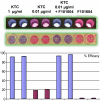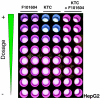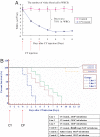High-throughput synergy screening identifies microbial metabolites as combination agents for the treatment of fungal infections
- PMID: 17360571
- PMCID: PMC1838648
- DOI: 10.1073/pnas.0609370104
High-throughput synergy screening identifies microbial metabolites as combination agents for the treatment of fungal infections
Abstract
The high mortality rate of immunocompromised patients with fungal infections and the limited availability of highly efficacious and safe agents demand the development of new antifungal therapeutics. To rapidly discover such agents, we developed a high-throughput synergy screening (HTSS) strategy for novel microbial natural products. Specifically, a microbial natural product library was screened for hits that synergize the effect of a low dosage of ketoconazole (KTC) that alone shows little detectable fungicidal activity. Through screening of approximately 20,000 microbial extracts, 12 hits were identified with broad-spectrum antifungal activity. Seven of them showed little cytotoxicity against human hepatoma cells. Fractionation of the active extracts revealed beauvericin (BEA) as the most potent component, because it dramatically synergized KTC activity against diverse fungal pathogens by a checkerboard assay. Significantly, in our immunocompromised mouse model, combinations of BEA (0.5 mg/kg) and KTC (0.5 mg/kg) prolonged survival of the host infected with Candida parapsilosis and reduced fungal colony counts in animal organs including kidneys, lungs, and brains. Such an effect was not achieved even with the high dose of 50 mg/kg KTC. These data support synergism between BEA and KTC and thereby a prospective strategy for antifungal therapy.
Conflict of interest statement
The authors declare no conflict of interest.
Figures




Similar articles
-
Alternative treatment of fungal infections: Synergy with non-antifungal agents.Mycoses. 2021 Mar;64(3):232-244. doi: 10.1111/myc.13203. Epub 2020 Nov 5. Mycoses. 2021. PMID: 33098146 Review.
-
Small molecules restore azole activity against drug-tolerant and drug-resistant Candida isolates.mBio. 2023 Aug 31;14(4):e0047923. doi: 10.1128/mbio.00479-23. Epub 2023 Jun 16. mBio. 2023. PMID: 37326546 Free PMC article.
-
Activity of ketoconazole against Mycobacterium tuberculosis in vitro and in the mouse model.J Med Microbiol. 2007 Aug;56(Pt 8):1047-1051. doi: 10.1099/jmm.0.47058-0. J Med Microbiol. 2007. PMID: 17644711
-
The synergistic antifungal activity of resveratrol with azoles against Candida albicans.Lett Appl Microbiol. 2021 Jun;72(6):688-697. doi: 10.1111/lam.13458. Epub 2021 Feb 22. Lett Appl Microbiol. 2021. PMID: 33550599
-
Posaconazole: a new broad-spectrum antifungal agent.Expert Opin Pharmacother. 2007 Jun;8(8):1167-78. doi: 10.1517/14656566.8.8.1167. Expert Opin Pharmacother. 2007. PMID: 17516880 Review.
Cited by
-
Beauvericin Potentiates Azole Activity via Inhibition of Multidrug Efflux, Blocks Candida albicans Morphogenesis, and Is Effluxed via Yor1 and Circuitry Controlled by Zcf29.Antimicrob Agents Chemother. 2016 Nov 21;60(12):7468-7480. doi: 10.1128/AAC.01959-16. Print 2016 Dec. Antimicrob Agents Chemother. 2016. PMID: 27736764 Free PMC article.
-
Synergistic combinations of antifungals and anti-virulence agents to fight against Candida albicans.Virulence. 2015;6(4):362-71. doi: 10.1080/21505594.2015.1039885. Virulence. 2015. PMID: 26048362 Free PMC article. Review.
-
Dual action antifungal small molecule modulates multidrug efflux and TOR signaling.Nat Chem Biol. 2016 Oct;12(10):867-75. doi: 10.1038/nchembio.2165. Epub 2016 Aug 29. Nat Chem Biol. 2016. PMID: 27571477 Free PMC article.
-
Additive Dose Response Models: Defining Synergy.Front Pharmacol. 2019 Nov 26;10:1384. doi: 10.3389/fphar.2019.01384. eCollection 2019. Front Pharmacol. 2019. PMID: 31849651 Free PMC article.
-
On the Potential Role of the (Pseudo-) Jahn-Teller Effect in the Membrane Transport Processes: Enniatin B and Beauvericin.Molecules. 2023 Aug 27;28(17):6264. doi: 10.3390/molecules28176264. Molecules. 2023. PMID: 37687093 Free PMC article.
References
-
- Eckmanns T, Ruden H, Gastmeier P. J Infect Dis. 2006;193:1408–1418. - PubMed
-
- Goodman JL, Winston DJ, Greenfield RA, Chandrasekar PH, Fox B, Kaizer H, Shadduck RK, Shea TC, Stiff P, Friedman DJ, et al. N Engl J Med. 1992;326:845–851. - PubMed
-
- Sanchez V, Vasquez JA, Barth-Jones D, Dembry L, Sobel JD, Zervus MJ. Am J Med. 1993;94:577–582. - PubMed
Publication types
MeSH terms
Substances
LinkOut - more resources
Full Text Sources
Medical

